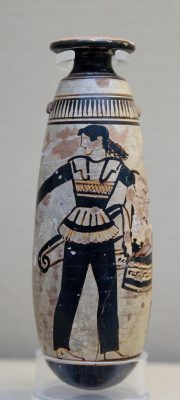The Toponym
Situated in the southeast of the city of Samsun, Terme (formerly spelled Termeh; Ancient Grk.: Thérmai – Θέρμαι; ‘spa’) is named after the Terme River (Grk: Thermodon – Θερμώδων); the latter place-name is documented since 600 B.C. Scholars have identified Terme or its environs as the site of the ancient city of Themiskyra (Θεμίσκυρα). Since 1835, the capital of the kaza was also known as Fenk (from Armenian ‘vank’ – ‘monastery’). The district center is still known as Fenk Mahallesi.[1]
Armenian Population
“Of the 3,427 Armenians in this kaza in 1914, only some 100 people lived in the principal town of the kaza, Terme. Most of the Armenian population was concentrated in four villages nearby: Kocaman (1,965 Armenians), located on a height half an hour from the sea, Alemdaz (pop. 560), Suluca (200), and Hoyla. We know nothing about what became oft these villages.”(2)
Themiskyra: Country of origin of the Amazons
Amazons (ancient Grk: Ἀμαζόνες Amazónes) are a term used in

ancient Greek myths and sagas to describe some peoples where women went into battle ‘like men’. The ethymology of the word is not clarified. A number of ancient *-/authors attributed the Greek term ‘Amazon’ to a-mazos (ἀμαζός ‘breastless’). For the Amazons are said to have mutilated the right breast of their little daughters so that they could later shoot the bow unhindered. But in the Greek representations Amazons were usually depicted with two breasts. They were probably matriarchal people, with matrilinearity in their inheritance law.
Ancient authors locate Amazon peoples mainly in the northern Anatolian part of the Pontos area, where their capital Themiskyra (Trk.: Terme) is said to have been located at the Thermodon river (Trk.: Terme Çayı). However, only one Greek city of this name is credibly documented by ancient sources. The surrounding landscape, which began about 11 km away from Amisos (Samsun) and stretched from Chadisia and Lykastos in the west to the Thermodon, was of same name, crossed by the lower Iris and bordered in the south by a part of the Tauros Mountains.
Strabo describes the landscape of Themiskyra as extremely fertile and rich in animals. The city was crossed by the Thermodon and was situated at its mouth in the Iris. No remains of the city have yet been discovered.
During the Third Mithridatic War (74-63 B.C.) the city was besieged by the Roman commander Lucullus and after long resistance, during which the inhabitants finally used bears and wild animals, it was captured, looted and apparently destroyed. Although Themiskyra no longer existed in late antiquity and thus did not become a bishop’s see, the titular Bishopric of Themiscyra is named after Themiskyra.
Deportations and Expulsions during WW1
Smothering Newborn Babies for Collective Survival: Sophia Stambolidou’s Testimony
As in other areas of Asia Minor, Greeks in the kaza Thermi were expelled from their villages and sought refuge in the mountains. In order not to reveal their hiding places to their persecutors, they decided to kill their youngest children.
“I was born in the village of Tsegeri, Thermi/Thermohonta district, Pontus, in 1910. The deportations, the privtions, the hardships, began in 1915-16. From that time on, we lived in the forests. I remember my mother telling me, as we hid in the woods: You are young and without sin. Say your prayers for God’s help.
I remember in the district of Goulouts-Teresi, where the Turkish Army had encircled us, our guerilla fighters, after battling all day and seeing that the Turks were very numerous, saw that the women and children had to be moved to a safer location. Before we left, however, our leaders agreed to smother the very young, as they feared that the cries of the babes-in-arms would betray us all and none of us would survive. One of those smothered was the child of my brother, Chrysostomos Kyriakidis. The father of one little girl, Konstantinos Toutsoglides, could not bring himself to smother her, so he left her behind. A few days later, we found her alive and she was eventually brought to Hellas with us, to Oinoe village, Kastoria.
The group was moved to a large forest, near the village of Ayios Ioannis [St John], Keris district. The Turks froze in fear when they found our smothered children. They realized our guerilla fighters were determined to do whatever it took.
We came to Hellas with the Exchange of Population in 1923, via Romania, to Thessaloniki. After a few days there, we were sent to the village of Neo Petritsi (Serres prefecture, eastern Macedonia), about Christmas 1923. We spent a few days in the village school, and were then taken, in the depths of winter, to the Bulgarian border to the village Mesaia. In 1957, we moved to Hrani village, Katerini district (Pieria prefecture, southern Macedonia).”
Source: http://www.efxinospontos.org/pontoshistory/testimonials.html